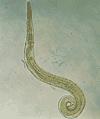- pinworm
-
/pin"werrm'/, n.a small nematode worm, Enterobius vermicularis, infesting the intestine and migrating to the rectum and anus, esp. in children.[1905-10; PIN + WORM]
* * *
Female pinworms may be 0.5 in. (13 mm) long; males are much smaller. Pinworms have a very long tail that gives them a pinlike appearance. They mate in the upper gastrointestinal tract, usually in the large intestine; the females travel to the anus, deposit their fertilized eggs on the skin near the anal opening, and die. The worms' movements cause itching; eggs transferred to the fingernails when the victim scratches may be passed to the mouth. Eggs can also be inhaled with air dust. The eggs or larvae make their way to the intestine, and the cycle begins again. Pinworm (Enterobius vermicularis)Walter Dawn
Pinworm (Enterobius vermicularis)Walter Dawn* * *
▪ wormworm belonging to the family Oxyuridae in the order Ascaridida (phylum Nematoda). Pinworms are common human intestinal parasites (parasitism), especially in children. They are also found in other vertebrates. Male pinworms are 2 to 5 mm (about 0.08 to 0.2 inch) long; females range in length from 8 to 13 mm. The long tails of the worms give them a pinlike appearance.Pinworms usually occur in the large intestine but sometimes are found in the small intestine, the stomach, or farther up the gastrointestinal tract. After the eggs are fertilized by the male, the female travels to the anus, deposits the eggs on the skin near the anal opening, and usually dies. Movements of the worm on the skin cause itching. Eggs, transferred beneath the fingernails by scratching, are passed to the mouth, from which the eggs or larvae make their way to the intestine. The life cycle requires 15 to 43 days.* * *
Universalium. 2010.
